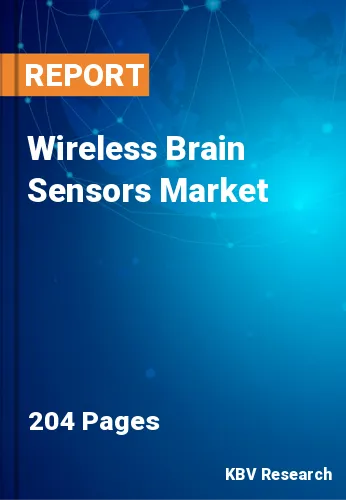The Global Wireless Brain Sensors Market size is expected to reach $679 Million by 2026, rising at a market growth of 12.8% CAGR during the forecast period. The growing adoption of inactive lifestyles across the world is one of the primary factors fueling the market for wireless brain sensors. Unhealthy lifestyle decisions, for example, alcohol addiction and smoking are among the significant factors causing stroke and migraine. As indicated by the NCBI, some of the components of lifestyles that impact health are Diet and weight record, Exercise, Rest and Substance misuse, and Drug misuse.

Stroke is the main cause of mortality and morbidity because of the adoption of unhealthy lifestyles. In the U.S., around 70,000 individuals experience a stroke each year, out of which 23.0% of strokes are lethal or cause lasting disability. Furthermore, smoking is another significant risk element that causes hemorrhagic and ischemic stroke. Since wireless brain sensors assist with overseeing and forestall such conditions, in this manner, expanding the adoption of unhealthy lifestyle choices is probably going to propel the market for wireless brain sensors.

The growing instances of Traumatic Brain Injuries (TBI) are additionally one of the significant drivers decidedly affecting the development of the market for wireless brain sensors. TBIs, because of a blow, bump, or shock to the skull cause lasting or temporary impairment of the brain. Significant reasons for TBIs incorporate sports injuries, falls, gunshot injuries, domestic violence, and road traffic accidents. TBI is one of the main causes of morbidity and mortality, and significant public health concern in developed and developing nations.
The growing adoption of sedentary or inactive lifestyles across the world is one of the significant elements boosting the wireless brain sensor market during the forecast period. The harmful lifestyles choice like addiction to alcohol and smoking are among the vital causes that lead to migraine and stroke. As per the NCBI, a few of the lifestyle factors that impact health are Diet and weight, Exercise, Rest, and Substance and Drug addiction. One of the major causes of mortality and morbidity across the world is stroke. In the U.S. alone, approx., 70,000 people suffer from stroke each year, in which around 23% of strokes are deadly or result in a lifetime disability. Additionally, smoking is also a significant risk element that results in hemorrhagic and ischemic stroke. Since the wireless brain sensors assisting in managing and preventing such problems, hence, growing adoption of sedentary and unhealthy lifestyles is going to fuel the wireless brain sensors market.
| Report Attribute | Details |
|---|---|
| Market size value in 2019 | USD 341.4 Million |
| Market size forecast in 2026 | USD 679 Million |
| Base Year | 2019 |
| Historical Period | 2016 to 2018 |
| Forecast Period | 2020 to 2026 |
| Revenue Growth Rate | CAGR of 12.8% from 2020 to 2026 |
| Number of Pages | 204 |
| Number of Tables | 380 |
| Report coverage | Market Trends, Revenue Estimation and Forecast, Segmentation Analysis, Regional and Country Breakdown, Companies Strategic Developments, Company Profiling |
| Segments covered | End Use, Product, Application, Region |
| Country scope | US, Canada, Mexico, Germany, UK, France, Russia, Spain, Italy, China, Japan, India, South Korea, Singapore, Malaysia, Brazil, Argentina, UAE, Saudi Arabia, South Africa, Nigeria |
| Growth Drivers |
|
| Restraints |
|
Free Valuable Insights: Global Wireless Brain Sensors Market to reach a market size of $679 Million by 2026
Based on End Use, the market is segmented into Multispecialty hospitals, Research institutes and Others. Based on Product, the market is segmented into Electroencephalography (EEG) Devices, Sleep Monitoring Devices, Intracranial Pressure (ICP) Monitors, Transcranial Doppler (TCD) Devices and Others. Based on Application, the market is segmented into Traumatic Brain Injuries, Parkinson's Disease, Epilepsy, Dementia and Others. Based on Regions, the market is segmented into North America, Europe, Asia Pacific, and Latin America, Middle East & Africa.
The market research report covers the analysis of key stake holders of the market. Key companies profiled in the report include Novo Nordisk A/S, Koninklijke Philips N.V., Natus Medical Incorporated, Neuroelectrics, Brain Products GmbH, NeuroSky, Inc., Advanced Brain Monitoring, Inc., Hangzhou Zhongheng Electric Co., Ltd., Neuronetrix Solutions, LLC and EMOTIV, Inc.
Market Segmentation:
By End-Use
By Product
By Application
By Geography
Companies Profiled
The global wireless brain sensors market size is expected to reach $679 million by 2026.
There are several reason that cause high demand of this market one of them is rising incidents of brain injuries and other neurological problems.
Novo Nordisk A/S, Koninklijke Philips N.V., Natus Medical Incorporated, Neuroelectrics, Brain Products GmbH, NeuroSky, Inc., Advanced Brain Monitoring, Inc., Hangzhou Zhongheng Electric Co., Ltd., Neuronetrix Solutions, LLC and EMOTIV, Inc.
The expected CAGR of wireless brain sensors market is 12.8% from 2020 to 2026.
Our team of dedicated experts can provide you with attractive expansion opportunities for your business.

